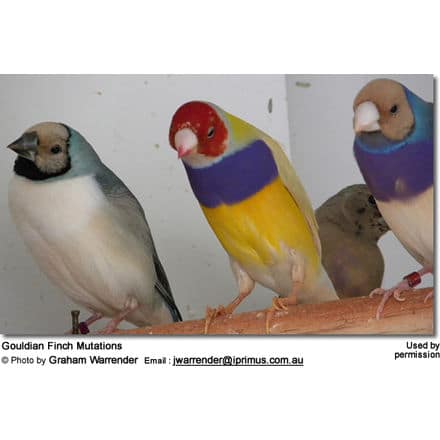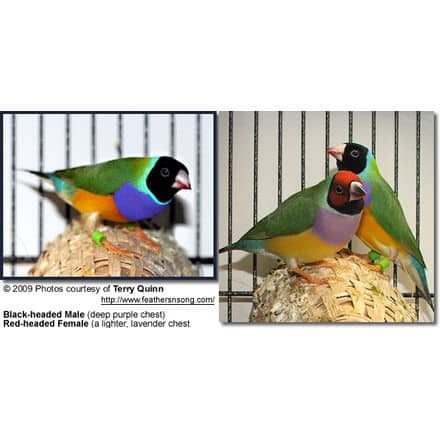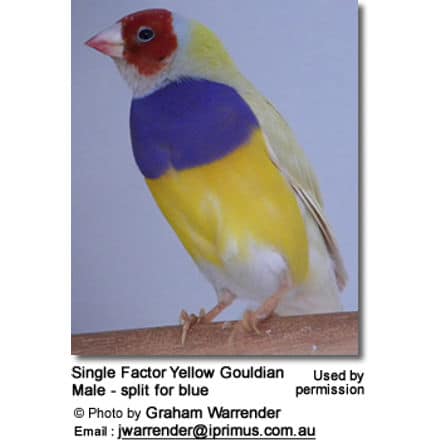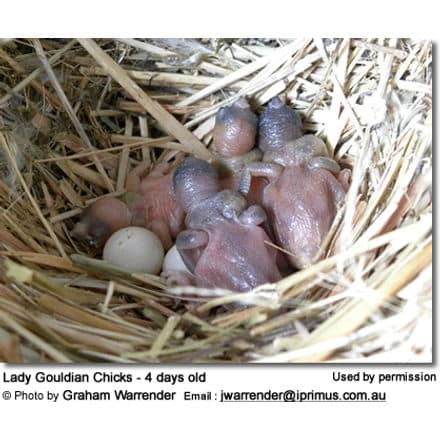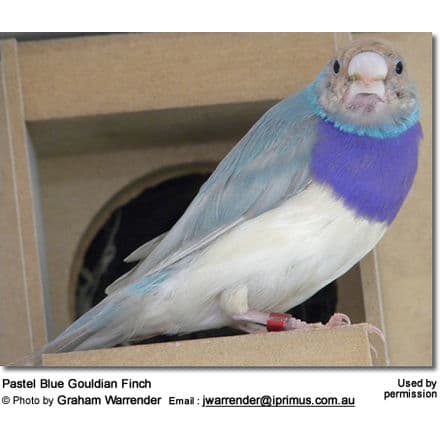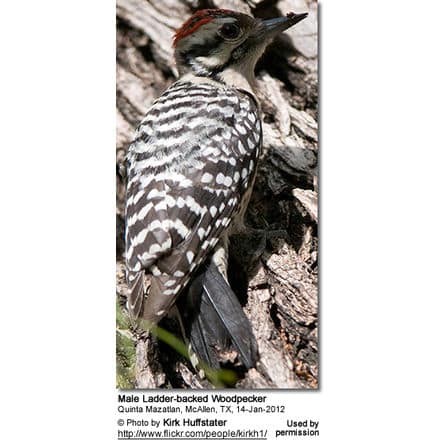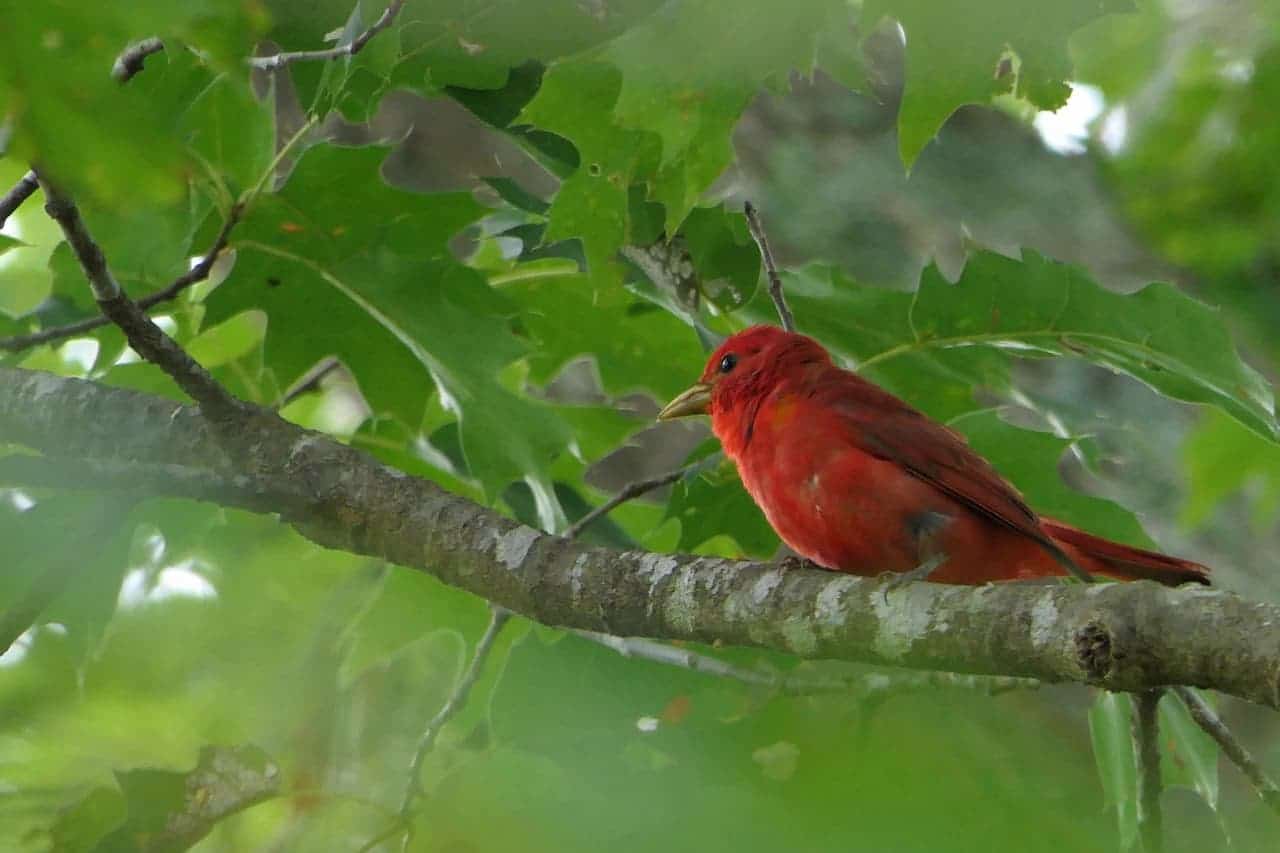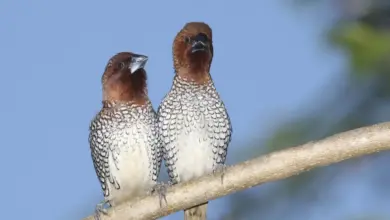Gouldian Finches Breeding / Nesting
Related Web Resources: Finch Information … Index of Finch Species … Photos of the Different Finch Species for Identification … Common Health Problems of Finches
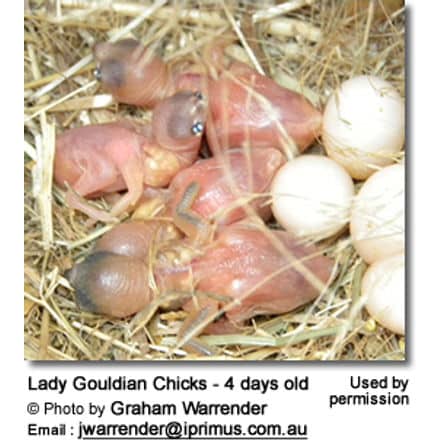
Distribution / Habitat … Description
Breeding / Nesting (below) … Diet / Feeding … Life Cycle
Aviculture: Breeding / Nesting
The Gouldian finches can be difficult to breed outside its native climate of Australia but does well when given the right conditions. Gouldians bond and mate for life. These delicate finches need a clean environment and excellent nutrition to thrive. The gravel should be replaced at least once a month and the whole cage should be cleaned and disinfected frequently.
Many mutations occur in aviculture. Yellow, dilute, blue, silver, white and even albino gouldian finches have been bred — all of which are breathtaking.
- Please refer to this webpage for photos in addition to the contact information of a breeder.
In the wild, Gouldian finches generally make their nests in tree holes and they breed in the early part of the dry season, when plenty of food is available. In captivity, they usually nest in finch nest boxes of covered wicker baskets.
The male courtship dance is a fascinating spectacle. When a male is courting a female, he bobs about ruffling his feathers to show off his colors. He expands his chest and fluffs out his forehead feathers. After mating, a female lays a clutch of about 4–8 eggs. Both parents help brood the eggs during the daytime, and the female stays on the eggs at night. When the eggs hatch, both parents help care for the young. Gouldian Finches leave the nest at between 19 and 23 days and are independent at 40 days old.
Young Gouldians are very fragile until their final moult. Some breeders believe parent-raised Gouldians have greater success rearing young than those fostered by other species, such as society or spice finches.
It has been shown scientifically that female finches from Northern Australia are controlling the sex of their offspring, according to the head color of their male counterpart. Gouldian Finches are incompatible with Gouldian Finches with a different head color and mating with a Gouldian Finch with the wrong head color (black-head with red-head etc.) usually has fatal results for the chicks — female chicks especially will die, while male chicks have a better chance of survival. Therefore, with a wrong head color mating, the female will lay fewer eggs with more male offspring.
Personal Experiences with Gouldian Finches
As a former breeder, I must admit that they were challenging to manage. They are known to be more delicate, more sensitive to temperature differences – and there is a good chance that the gouldian finch that you buy suffers from airsack mites. If your gouldian suffers from respiratory problems, then this would be the first thing to check out.
Additionally, the gouldian finches are not known for their parenting skills. Many breeders have zebra or society finches foster the gouldian finch eggs / chicks to increase survival rate.
They are wonderful finches and – because of their beauty and difficulty in breeding – are more pricey than other finches – last time I checked they were around $100 and up. With this breed, it is particularly important to know your source when you decide to go ahead with purchasing these finches. See if you can get a vet referral, or a recommendation by someone you know.
A vet check is recommended. If you add one sick bird to your aviary of healthy finches, you run the risk of infecting them all. As healthy as your newly purchased finch may look — he or she may be a carrier or at the early stage of disease development without any outwardly visible signs.
I have asked successful Gouldian Finch Breeders – Mandy and Paul from Singing Wings Aviary – Website: www.singing-wings-aviary.com – how they achieved their breeding success with the challenging Gouldian Finch. This is their input:
“First you have to start with healthy Gouldians to breed. Actually, birds acclimated to a variety of temperatures seem to be hardier. Especially when being shipped, etc. . Also juveniles are more prone to stress than adults in full color.
Gouldians do have a higher protein and iodine requirement then Zebras and other of the more common Finches. This is commonly overlooked. We offer ours Goulds five different treat cups. One with Herb salad, one with powdered kelp (iodine), one with Petamine (vit/min. supplement) and one with bird charcoal. Spray millet is also given on reg. basis. We also give “homemade eggfood with broccoli tops and grated carrot and wheat germ oil and eggshell mixed in 3 x per week to non-breeders and every day to those with babies or Juvies coloring up.
Also prevent air sac mites by treating with SCATT 2-3 times a year.
We breed our Goulds in box type cages (solid walls with wire only on the front). This gives pairs more privacy. We offer the pairs (one pair per breeding cage) a Gourd nest and a nest box. Most pick the Gourds. Temps in our aviary range from 60 degrees (coldest) to 100 degrees (warmest). We always offer a heat lamp on one side of the aviary for Juvies and this stays on 247 even during summer…also doubles as a dim night light.”
Email: [email protected]– Website: www.singing-wings-aviary.com
- Please refer to this webpage for photos of mutations they have raised.
Species Research by Sibylle Johnson
Please Note: The articles or images on this page are the sole property of the authors or photographers. Please contact them directly with respect to any copyright or licensing questions. Thank you.

